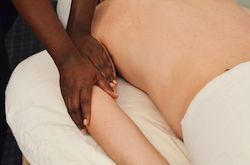
In a previous blog, Greg Hurd explained Why Position Statements Matter. Here Delegate Kate Peck examines one position statement being brought to the House of Delegates at the National Convention. We encourage your comments and thoughts below this post!
Proposed position Statement: It is the position of the American Massage Therapy Association (AMTA) that massage therapy can assist in the rehabilitation of burn scars. You can read the full text here.
Every year an estimated 450,000 Americans are treated in hospitals for burn injuries.1 Of those, 30-91% will result in hypertrophic scarring.3 Hypertrophic scarring is a scar that becomes raised above the skin surface. It can be thick, irregular, and/or rough. It is usually found in larger and deeper wounds, wounds that require a skin graft, and wounds that take a long time to heal. 2,3,9,11,15,19,21,22,23,24,25,26,27 Research has shown that massage therapy has shown improvements in vascularity, pigmentation, texture, thickness, and pliability. 2,4,11,19,26,29,30,31 Massage can decrease pain and sensitivity of the scars.2,13,14,16,17 decrease pruritus(itching), 2,13,17,19,29 and increase range of motion.36,37 Massage can also decrease depression, 14,29 anxiety13,14,17 and anger14; and enhance mood & relaxation. 13
There are 40 different references listed to back up this statement. 19 are research studies & 21 are informational articles on burns, burn scars & associated symptoms, and burn care. Of the 19 research studies, only 13 study the effects of massage and burn scars.
Four studies report the psychological benefits of massage for burn victims:
- 2 studies report a decrease depression. (14,29)
- 3 studies report a decrease in anxiety & anger. (13,14,17)
- 1 study reports an improved mood. (13)
Nine studies report the physical benefits:
- 5 studies report decreased pain. (#2,13,14,16,17).
- 5 studies report a decrease in pruritis/itching. (#2,13,17,19,29)
- 2 studies report increased mobility/range of motion (ROM). (#36,37)
Onereference mentions massage before debridement procedures (#14). It reported decreased state anxiety & cortisol levels, improved behavior ratings of state, activity, vocalizations & anxiety with adult patients in the massage therapy group vs. the standard treatment group. It also reported long term benefits such as decreased depression & anger, and decreased pain.
Of the 13 studies referenced, only 1 study failed to show “an appreciable effect” of massage therapy on burn scars. #32 reports the effects of friction massage w/ the use of pressure garments vs. pressure garments alone. Friction massage was performed 10 min./day for 3 months on a group of 30 pediatric patients. They found no effect on vascularity, pliability, & height of scar, but decreased pruritis in some patients. Since only friction massage was performed, and I’m not sure of the appropriateness of using friction massage on burns of pediatric patients, it should not take away from the other effects of massage on burn scars.
One reference appear to be irrelevant, and in my opinion, none of these should have been included. One is research reporting the effects of music & exercise with children. (#20)
Summary/conclusion:
Most health professionals agree that massage should be included in any burn scar rehabilitation program. 17 We all know the benefit of healing touch goes far beyond the physical effects on the scar tissue itself. Burn survivors in particular experience a significant lack of caring touch due to the nature of their injury. The research presented here shows that there is a consistent relationship between the effects & benefits of massage therapy and burn scar recovery. However, there is not a lot of research on massage and burn scars. How much is enough? That’s a good question.
Image courtesy of ryanhoyme.com
